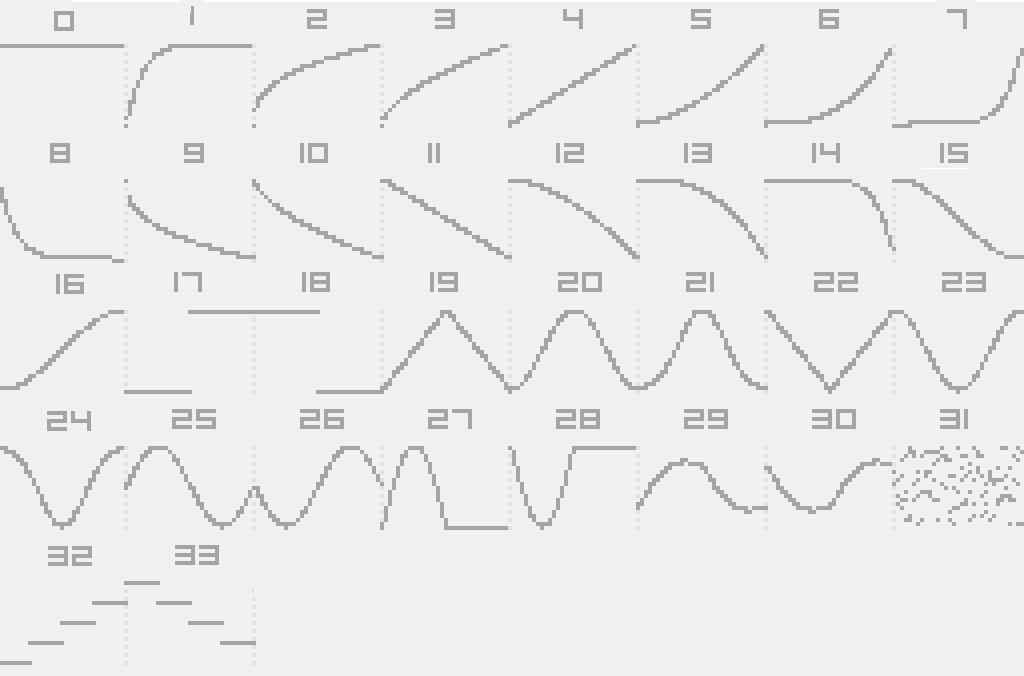Shape sequencer
This is an advanced modulator that lets you draw complex automation envelopes, create wave-sequencing effects, or even simple sequences, on a per-step basis.
Main features of this shape sequencer :
- Sequence from 1 to 256 steps
- Can be played in forward, reverse, ping-pong or random
- Steps can be synchronized to a clock (1/64, 1/32, 1/16, 1/4, 1/2, 1 BAR, 2BAR, 4BAR, 8BAR, 16BAR)...
- ...or be trigged manually using a gate input, or a Note On (if used as an instrument modulator)
- Multiple parameters per step (Shape, min value, max value, repeat (from 1 to 8), chance, fade in/out
- 34 different shapes available
Main screen of the shape sequencer (in edit mode)
The shape sequencer comes in two different working modes :
- Edit mode : more suitable to precisely edit all parameter for a selected step. The 4 potentiometers in this case controls different parameters of this step
- Perf mode : more suitable in "live", to edit the same parameter on different step using the four potentiometers (corresponding to 4 different steps)
Menu
Click the Encoder to bring up a contextual menu which contains the following operations:
- Perf Mode : switch to Performance Mode (Please refer to the paragraph below for more informations on this)
- Randomize This Step - selects a random shape for the currently selected step
- Randomize All Steps - selects a random shape for each and every step of the sequencer
- Randomize All : Note Seq - generates a random sequence of fixed values, like a standard step-sequencer
- Randomize All : Pluck Seq - generates a sequence of plucked shapes with ratcheting
- Reset all - initializes the entire sequence to the default template
Click the encoder to launch the selected operation.
Steps Tab
Edit Mode
This is the default mode of operating the sequencer, and the one you land on when first opening the Shape Sequencer.
Turn the Encoder to scroll to the step you want to edit, which is the one highlighted, one page contains 8 steps, it automatically change the page after 8 steps.
The Steps tab has 2 pages. Click its button (Button 1) to cycle between pages.
Page 1 allows you to select and modify the shape of the selected step. Note that these parameters cannot be modulated.
| Shape | Minimum | Maximum | Repeat |
| Select one of the 34 shapes available | Stretch the shape by "squashing it" towards the top when you turn clockwise. Like resizing a picture. | Stretch the shape by "squashing it" towards the bottom when you turn counter-clockwise. Like resizing a picture. |
A ratcheting effect. Set how many times the shape cycles, for the duration of the step. Select between 1 and 8 repeats |
Page 2 contains more parameters for the selected step. Note that these parameters cannot be modulated.
| Chance | Fade | - | - |
| Set the probability for the step to play. If a step does not play, the sequencer output stays at the previous value until the step is completed. | Apply a fade-in (counter-clockwise) or a fade-out (clockwise) to the shape | - | - |
Performance Mode
It's an alternative display mode for the Shape Sequencer where all the parameter of the Steps tab from Edit Mode are remapped so you can edit the same parameter across multiple steps quickly. Note that these parameters cannot be modulated.
4 steps are displayed at a time, and you can drag the display across the sequence by scrolling the encoder.
Click one of the buttons to select the parameter you want to edit, which is labelled on the corresponding tab.
Tab 2 and Tab 4 have two pages each, respectively Min/Max and Chance/Fade.
Knob 1 will edit the selected parameter for step 1, Knob 2 will edit the selected parameter for step 2, and so on.
It's always the same sequence that you're editing, so you can freely toggle between Edit and Performance Mode.
Click the Encoder to bring up the same contextual menu as in Edit Mode, but in this one the first option is to switch back to Edit Mode.
You will need to be in Edit Mode to access the other tabs of the Shape Sequencer :
Sequence Tab
Here you will find the main parameter of the sequencer:
| Steps | Play Mode | - | - |
| Select the number of steps in the sequence, from 1 to 256. Can be modulated. |
Select how the sequence is played. The options are: Off (freezes on the currently playing step, looping it), Forward, Reverse, Ping-Pong and Random. Can be modulated. |
- | - |
Trigger / Speed Tab
Here you will find parameters regarding the sequence playback. Note that these parameters cannot be modulated.
| Trig Mode | Clock | Trigger | - |
| Select how the sequencer moves to the next step. Clock means it advances at the selected clock rate, Trigger means it advances each time the specified trigger is received. |
Select the rate at which the steps and their shapes are played back, in divisions or multiplications of the Clock. If the sequencer is in Clock mode, this will also be the rate at which the sequencer moves to the next step. |
Select a source to advance the sequencer in Trigger Mode. It can be any of the Gate Inputs, or the same signal that triggers the Voice. | - |
Output Tab
Here you can sculpt the sequence output before it's sent to the modulation targets:
| Polarity | Gain | - | - |
|
Select the sequence output polarity between :
Can be modulated. |
Set the level of the sequence output.
Can be modulated |
- | - |
Shapes reference





No Comments